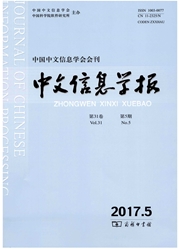

 中文摘要:
中文摘要:
郾城方言存在两种小称变调:高降调和低升调。在亲属称谓词中,高降调多为成年人和无亲缘关系的人使用,表示讨好和拉近关系,听感上短促生硬;低升调多为儿童和有亲缘关系的人使用,表示喜爱亲密,听感上长而自然。在亲属称谓词重叠变调中,存在两种不同的音步模式:扬抑格和抑扬格。扬抑格表现为左重右轻,抑扬格表现为左短右长。郾城方言可能分别使用了“高”和“长”两种手段表示两种不同性质的小称。
 英文摘要:
英文摘要:
This article separates tone change from Er suftixation and reduplication and further analyzes the relation between tone change and diminutive, focusing on Yancheng(郾城) dialect. The findings suggest that there are two types of diminutive tone change, 13 tone and 53 tone, indicating different emotions and distributed in different groups. Meanwhile, two types of foot patterns are utilized to form different reduplication patterns in relative appellation: Iamb and Trochee. The former presents high-low alternation in pitch, while the latter short-long pattern in duration. Based on these observations, it is inferred that both pitch and duration might be used to express different types of intimacy respectively in Yancheng(郾城) dialect.
 同期刊论文项目
同期刊论文项目
 同项目期刊论文
同项目期刊论文
 期刊信息
期刊信息
